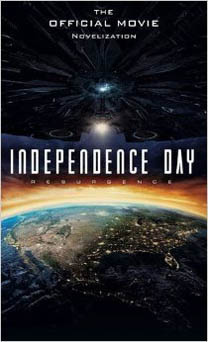To celebrate the 20th anniversary of “Independence Day” and the release of the sequel, “Resurgence,” this week I’m looking back at the various spinoff comics and novels. All of these spin-off materials were recently released (or re-released, in the case of the old stuff) by Titan Books. Also, check out my reviews of “Independence Day” and “Independence Day: Resurgence.”
Old-school novelizations, including “Independence Day’s,” tend to give a window into the script before it was finalized, with deleted and alternate scenes. Modern novelizations lean toward being more carefully planned out, so with Alex Irvine’s “Independence Day: Resurgence” novelization (June, paperback), we don’t get as many surprises. Still, it ties in smoothly with the prequel, “Crucible,” and it’s just nice that it exists in an age when novelizations are dying out.
The thing that makes the movie so fun – the kinetic multi-site battle of the final act – makes the novelization a bit tiresome toward the end, with lots of short blocks of text. And early in the book, since the backstories and catch-up stories for all the main characters were so well laid-out in “Crucible,” they are a bit redundant here.
The “ID:R” novelization isn’t totally without new insights, though. Because the movie moves so fast, I missed some of the location information. For example, the book makes it clear that Julius is in the Gulf of Mexico when the tidal wave hits, and he is picked up by the kids in Austin, Texas. And Jasmine Dubrow works as a nurse in Washington, D.C. On the other hand, if you want to know in which city Patricia and Jake were house-hunting, that’s not made clear. I assume it’s Washington, D.C.
Irvine adds three key elements that expand the mythology. First, we learn that the Earth Space Defense has bases not only on the Moon, but also on Mars and Rhea, a moon of Saturn. While the U.S. oversees the entire ESD, the Chinese have jurisdiction of the Moon, the French run Mars and the Russians man Rhea. I believe the movie makes a quick reference to ESD’s loss of contact with the Saturn base. The book chronicles the passage of the alien harvester ship tearing up the outposts at Rhea and Mars. These scenes play like Arthur C. Clarke Lite, which is faint praise, but it does kind of make me want to go on a Clarke kick.
Second, we get more of the fateful arc of President Lanford (played by Sela Ward). In the movie, if memory serves, we’re told that Cheyenne Mountain has been wiped out, thus necessitating that General Adams be sworn in as president because the next 17 (!) people in the line of succession were killed. In the book, we see Lanford stand up to the queen alien, and then it’s alluded that the queen finishes her off. “ID:R” straddles the fence with Lanford: On one hand, she’s not meant to be portrayed as an awful president; on the other hand, she goes to the Cheyenne bunker, something that Whitmore heroically chose not to do in “ID4.” So these additional scenes add some heroism to her portrayal.

Incidentally, I’m disappointed that the U.S. rebuilds NORAD at Cheyenne Mountain, which was effortlessly destroyed by the eebies in the first movie. In order to show the line of demarcation between the pre- and post-1996 culture, it would’ve been nice to see infrastructure built in new locations rather than everything being rebuilt in the same place, only bigger. That’s part of the fun of alternate histories, and it also would’ve de-emphasized the open secret that “ID:R” has the same plot as the original. The only notable way the saga embraces this idea is with Nevada’s Area 51 essentially becoming the new Pentagon, and a new town springing up around it.
The third interesting point is that the alien sphere tells Okun that its race created the eebies. Presumably, this comes straight from Devlin and Emmerich, as it’s a huge revelation. I almost wonder if this information’s inclusion in the book is accidental, because it seems like it could be a big bombshell for a third movie. Thematically, I can see the third film drawing a parallel between the sphere’s culture creating the destructive eebies and Earthlings’ genetic engineering. However, it seems like the public’s fear of genetic engineering is waning, and that could make the movie a bit dated, just as David’s recycling obsession firmly places “ID4” in the 1990s.
Still, “ID:R’s” world-building is fun, and I expect we’ll see Jake, Dylan, Patricia, Charlie and the other heroes using the sphere’s interstellar travel knowledge to take the fight to the eebies in future yarns that play like Clarke Lite or Heinlein Lite; it’s hard not to think of “Starship Troopers” when looking at where this franchise’s plot is headed.
While “ID:R’s” shaky performance at the box office puts a third film in doubt, the good news is that Devlin and Emmerich have been engaged with all the franchise’s spinoff materials, dating back to the first spinoff novel, “Silent Zone,” in 1997. It’s clear that they’re already thinking about how the plot continues in a potential third movie – it was originally proposed that a second and third film be shot back-to-back – so I feel confident that the story will continue someday, in some form.
Thanks for celebrating our “Independence Day” with me this week.

